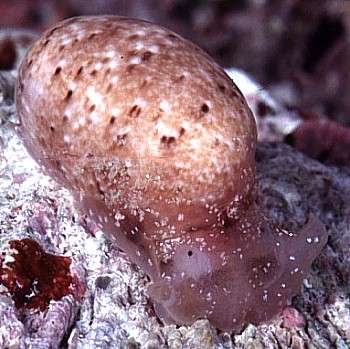Live Bulla from Kerama Island, Japan
November 12, 1999
From: Atsushi Ono


Dear, Bill
I found 2 individuals of CEPHALASPIDEA species at Kerama Is. [near Okinawa in Japan].
Length of shell are about 15mm, at 3m depth.
These are found only at night-diving, on dead coral and sandy bottom.
The lower photo has many dark brown patches on its shell. Are they Bulla ampulla?
Sincerely,
Atsushi Ono
ononini@cosmos.ne.jp
Ono, A., 1999 (Nov 12) Live Bulla from Kerama Island, Japan. [Message in] Sea Slug Forum. Australian Museum, Sydney. Available from http://www.seaslugforum.net/find/1511Dear Atsushi,
Many names and misindentifications surround the species of Bulla found in the Indo-West Pacific. Three species were reviewed by Willan (1978), and two of these, B. vernicosa and B. angasi, would appear to be forms of B. ampulla, which was unfortunately not reviewed. While `typical' B. ampulla has an inflated shell with a rounded outer lip to the aperture, the other two `species' with a narrower aperture and a straight or slightly incurved outer lip, have an identical range of colour patterns. In New Caledonia, specimens ranging from typical B. ampulla in shape to the narrower B. vernicosa-B. angasi shape are found together in mixed populations.
Unfortunately little difference has been found in morphology of the radular teeth, or any other part of the anatomy, of the species of the genus that have been investigated. The radula of B. ampulla and B. vernicosa have been illustrated by Habe (1950) and aspects of the anatomy of B. angasi (as B. subtropicalis) were described by Rudman (1971b).
All tropical western Pacific species have very similarly shaped shells, are herbivorous and nocturnal, burrowing in soft sediment or hiding under coral slabs during the day.
Bulla orientalis Habe, Bulla angasi Pilsbry and Bulla subtropicalis Powell have the distinctive 'comet-like' markings on the shell, as in your lower photo lower shell. I suspect this may be a juvenile colour pattern.
Basically I am not sure and I don't see how question will be resolved, unless a new anatomical character is discovered.
Bill Rudman.
References:
•Willan, R.C. (1978) The nomenclature of three Pacific Bulla species. Journal of the Malacological Society of Australia, 4(1-2): 57-68.
•Rudman,W.B.,1971. Structure and functioning of the gut in the Bullomorpha (Opisthobranchia). Part 1. Herbivores. Journal of Natural History, 5: 647-675.
Related messages
-
Bulla vernicosa? from Philippines
From: Marina Poddubetskaia Ossokine, December 5, 2005 -
Bulla ampulla laying eggs
From: Binyamin Koretz, May 5, 2005 -
Re: Research on Bulla
From: Ana Karina Yepes Gomez, February 26, 2003 -
Research on Bulla
From: Manuel Malaquias, January 26, 2003 -
Spawn of Bulla ampulla?
From: Erwin Koehler, April 25, 2002 -
Bulla ampulla from the Philippines
From: Erwin Koehler, March 26, 2002 -
Bulla sp. from the Line Islands
From: Cory Pittman, November 8, 2001 -
Bulla gizzard plates
From: Paula M. Mikkelsen, July 11, 2001 -
Juvenile Bulla from Sulawesi
From: Lindsay Warren , June 7, 2001
